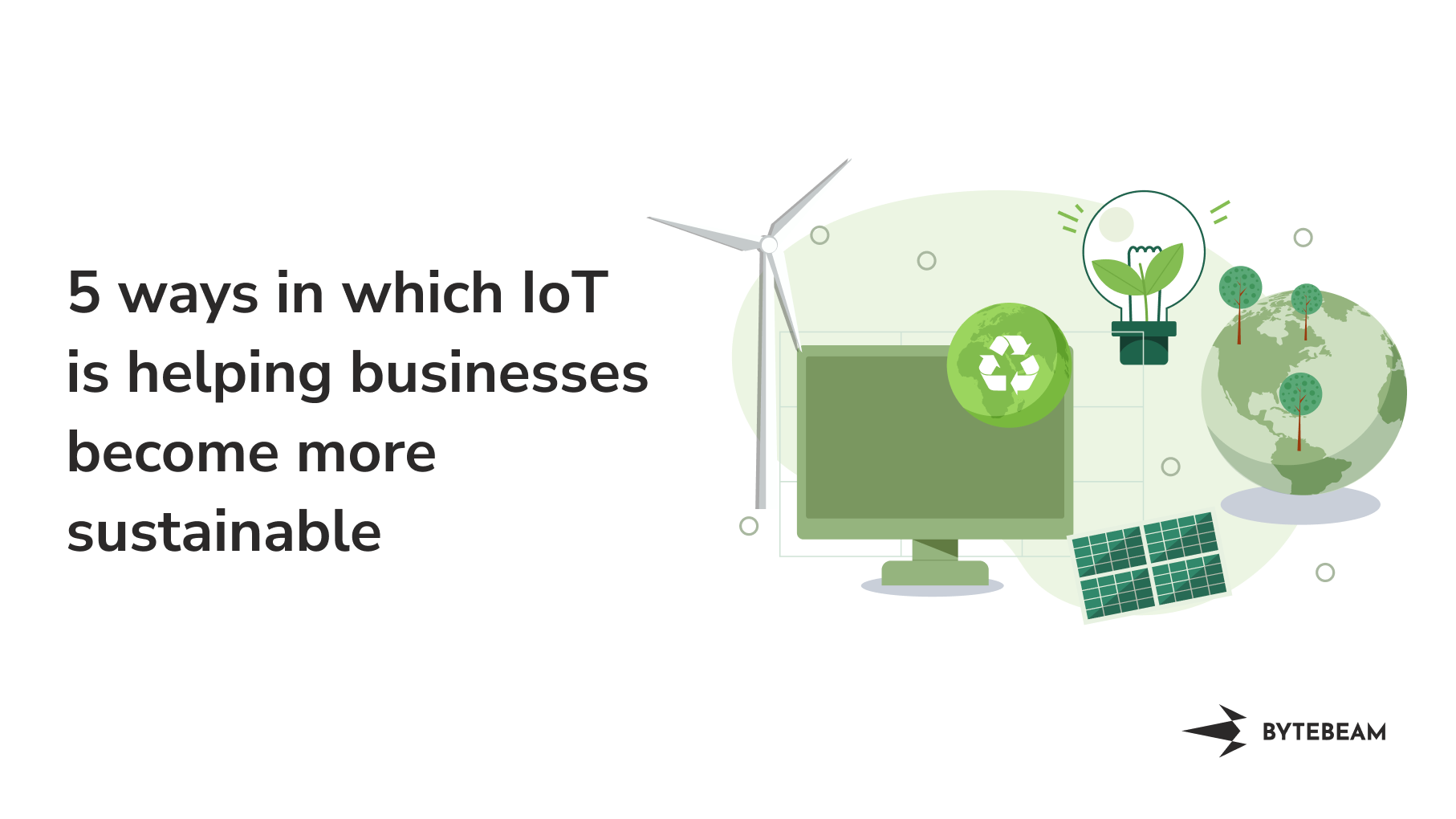5 ways IoT is helping businesses become more sustainable

In today’s day, it is not enough to be profitable, businesses also need to be sustainable.
If you think this is an altruistic perspective, think again. According to Mckinsey and Company, sustainability initiatives can increase operative profits by up to 60%.
Thankfully, emerging technologies are making this a much more achievable challenge today, compared to the previous decades. The Internet of Things (IoT) has emerged as a powerful tool to help businesses achieve their sustainability goals, by providing data-driven insights and real-time monitoring capabilities.
What to expect: In this article, we will take a look at how IoT is being used in sustainability and the benefits and challenges of using IoT for sustainability.
IoT applications around the world
IoT applications are becoming increasingly commonplace as the average price of sensors continues to decline. The following chart shows the prices of IoT sensors from 2004 to 2020.
Today, IoT applications can be found in a variety of industries, helping improve efficiency, optimize resources, and create new business models.
For example, IoT applications are being used to monitor and manage assets in the logistics industry. This data can be used to track inventory levels and ensure that products are being delivered to the correct locations.
In the retail industry, IoT applications are being used to improve customer service by providing real-time data on product availability.
IoT applications are also playing a role in creating smarter cities. For instance, connected traffic lights can help to reduce congestion and save fuel, while also reducing emissions. Similarly, connected homes can help to reduce energy consumption by automatically controlling lighting and appliances.
Overall, IoT applications are positively impacting businesses around the world. By helping to improve efficiency and optimize resources, IoT is playing a key role in making businesses more sustainable.
But there are specific ways in which IoT is spearheading sustainability efforts.
Top 5 ways IoT can help improve sustainability
Here are the top five ways IoT can help businesses become more sustainable.
Predictive maintenance
Predictive maintenance is a term used to describe the process of using data to predict when equipment is likely to need maintenance. By monitoring equipment for abnormal behavior, businesses can improve their maintenance schedules and save time and money.
IoT devices are playing an increasingly important role in predictive maintenance. By collecting data from sensors, these devices can help businesses detect problems before they cause downtime. In some cases, IoT devices can even trigger alerts when problems are detected.
There are many benefits of predictive maintenance. For businesses, it can help to reduce downtime, improve equipment utilisation, and extend the life of assets. In addition, predictive maintenance can also help businesses to save money on repairs and replacements.
IoT can be used to monitor equipment and predict when maintenance is needed, reducing downtime and energy waste. This not only saves resources, but also improves the overall efficiency of the equipment.
Water leak management
Water leaks can cause extensive damage to a property, leading to costly repairs. In order to avoid this, businesses need to be proactive about water leak management. IoT devices can play a key role in water leak management, helping businesses to identify leaks early and prevent water waste.
IoT-enabled water meters can help businesses keep track of their water usage. By monitoring the water consumption of a business, IoT devices can quickly identify when there is a sudden increase in usage. This could be an indicator of a water leak. By identifying leaks early, businesses can avoid extensive damage and save money on repairs.
IoT devices can also automatically shut off the water supply when a leak is detected. This helps to prevent further damage and wasted resources. In agricultural settings, IoT-connected sensors can help optimize irrigation, reducing water usage. And in industrial settings, IoT sensors can monitor wastewater discharge, helping to prevent water pollution.
By using IoT sensors, businesses can monitor water usage in real-time and quickly detect leaks. This allows for quicker response times and reduces water waste.
Environmental monitoring
IoT devices are helping businesses become more sustainable by monitoring environmental conditions and making decisions accordingly. For example, IoT devices can be used to monitor air quality, water quality, and soil moisture. This data can be used to make decisions about when to water crops, when to harvest crops, and when to apply pesticides. Additionally, this data can be used to predict future conditions and warn people of impending dangers.
Environmental monitoring is a critical part of making businesses more sustainable. By using IoT devices to collect data about environmental conditions, businesses can make better decisions that help them save time, money, and resources.
Reforestation
Reforestation is the replanting of trees in an area where the forest has been lost, typically through deforestation. Reforestation can help restore the original functions of the forest, including carbon sequestration, water regulation, and providing habitat for wildlife.
IoT devices are playing a role in reforestation efforts by providing data that can be used to replant trees and monitor their growth. For example, IoT sensors can be used to track the moisture levels in soil, which is important information for determining where to plant new trees. Additionally, IoT devices can be used to monitor the growth of trees and provide early warning signs of disease or pests.
Reforestation is an important part of mitigating climate change, as trees play a key role in absorbing carbon dioxide from the atmosphere. In addition, trees produce oxygen and help to regulate the water cycle. Reforestation can also help restore wildlife habitats and provide economic opportunities for communities.
IoT can be used to monitor the health of forests and track the growth of new trees. This data can be used to optimize reforestation efforts and improve the overall sustainability of forestry operations.
Ocean waste management
IoT is helping businesses become more sustainable by reducing ocean plastic waste. IoT sensors can help identify where ocean plastic is located, and IoT devices can be used to collect it. This data can help businesses save time and money, while also reducing their environmental impact.
Plastic pollution is a major problem for the world’s oceans. Every year, millions of tons of plastic waste end up in the ocean, which poses a threat to marine life, coastal economies, and the health of people who live near the coast.
IoT can play a key role in reducing ocean plastic waste. IoT sensors can be used to identify areas where there is a high concentration of plastic waste. This data can then be used to plan efficient clean-up operations. Additionally, IoT devices can be used to collect ocean plastic waste. This data can help businesses save time and money, while also reducing their environmental impact.
Collecting data on ocean plastic waste is important not only for clean-up efforts, but also for prevention. By understanding where ocean plastic waste comes from, businesses can take steps to reduce the amount of plastic waste that ends up in the ocean in the first place. For example, if data shows that a particular type of packaging is responsible for a high the percentage of ocean plastic waste, businesses can switch to using alternative packaging. For example, Drone enthusiast Peter Kohler has developed the Plastic Tide Project which uses drones to locate plastic on ocean surfaces. These drones hover over the ocean surface and locate plastic waste so that the cleanup efforts can be concentrated on those areas and the cleanup process is faster and more efficient.
IoT can be used to monitor ocean waste levels and track the movement of trash and debris. This data can be used to optimize waste management efforts and reduce the impact of ocean waste on marine ecosystems.
Final Thoughts
IoT has the potential to revolutionize the way businesses approach sustainability. By providing real-time data and insights, IoT can help businesses make informed decisions and take action to reduce their environmental impact. The future of sustainable business is one that is data-driven and powered by IoT.
Frequently Asked Questions
What is IoT in sustainability?
IoT in sustainability refers to the application of interconnected devices and sensors to promote eco-friendly practices, efficient resource utilization, and reduced environmental impact. By providing real-time data and automation, IoT facilitates smarter decision-making and operational adjustments that align with sustainable goals.
How can IoT help sustainability?
IoT aids sustainability by enabling real-time monitoring of resources, optimizing energy usage, automating waste reduction, enhancing agricultural practices, and providing data-driven insights for better environmental decision-making. It essentially helps in efficiently managing resources and reducing the environmental impact of various activities.
What impact will IoT have on sustaining the environment?
IoT will positively impact environmental sustainability by enabling efficient resource management, reducing waste, optimizing energy use, and monitoring environmental parameters. Through data-driven insights, IoT can facilitate proactive measures to mitigate environmental degradation and support conservation efforts.

